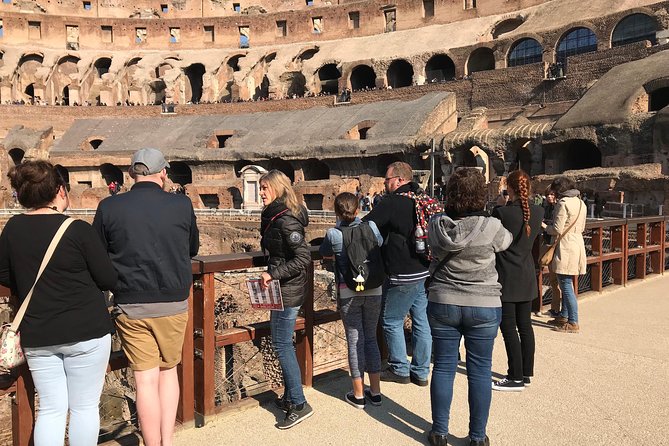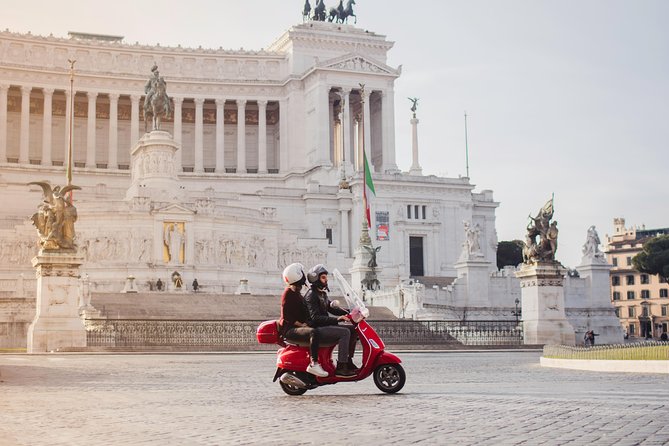Roma Trip Overview
Discover Rome in a different, eco-friendly and enjoyable way!
Explore the wonders of Rome on a Segway, accompanied by an experienced, professional, private tour guide.
Discover the magnificent ancient monuments of the third largest park in Rome
Visit the City Centre on a speedy, convenient and eco-friendly means of transport.
These are the advantages of taking a segway tour:
• Move around the city quickly and conveniently
• See the famous sights of the Eternal City from a new perspective
• Explore the city with zero environmental impact –Segway is a totally eco-friendly vehicle!
• Discover parts of the city that you won’t see on an ordinary tour itinerary
• Reliable, fully-trained, expert guides to show you all the secrets of RomeChoose from a wide range of tour options, which vary in terms of itinerary and duration.
Additional Info
Duration: 2 hours
Starts: Roma, Italy
Trip Category: Tours & Sightseeing >> Segway Tours
Explore Roma Promoted Experiences
What to Expect When Visiting Roma, Lazio, Italy
Discover Rome in a different, eco-friendly and enjoyable way!
Explore the wonders of Rome on a Segway, accompanied by an experienced, professional, private tour guide.
Discover the magnificent ancient monuments of the third largest park in Rome
Visit the City Centre on a speedy, convenient and eco-friendly means of transport.
These are the advantages of taking a segway tour:
• Move around the city quickly and conveniently
• See the famous sights of the Eternal City from a new perspective
• Explore the city with zero environmental impact –Segway is a totally eco-friendly vehicle!
• Discover parts of the city that you won’t see on an ordinary tour itinerary
• Reliable, fully-trained, expert guides to show you all the secrets of RomeChoose from a wide range of tour options, which vary in terms of itinerary and duration.
Itinerary
This is a typical itinerary for this product
Stop At: Segway Rome Net, Piazza del Popolo, 3, 00186 Roma RM, Italy
We were the first to introduce the Segway to Italy and develop the organised tour formula; we employ specially-trained, expert guides who will show you all the secret corners and mysteries of Rome. All that, and you get to explore the capital city on a speedy, convenient and eco-friendly means of transport. Microsoft, Coca-Cola e Ferrarelle have all taken Segway Roma tours; come and find out more at one of our rental points!
Duration: 3 minutes
Stop At: Terrazza del Pincio, Salita del Pincio 1, 00187 Rome Italy
The Pincian Hill is a hill in the northeast quadrant of the historical center of Rome. The hill lies to the north of the Quirinal, overlooking the Campus Martius. It was outside the original boundaries of the ancient city of Rome, and was not one of the Seven hills of Rome, but it lies within the wall built by Roman Emperor Aurelian between 270 and 273.
Pincio Terrace is one of the most favorite panoramic viewpoints by the Romans
Duration: 5 minutes
Stop At: Orologio ad Acqua, Viale dell’Orologio Pincio, 00100 Rome Italy
In 1867 Fr. Giovan Battista Embriaco, inventor and professor of the College of St. Thomas in Rome, created a hydrochronometer and sent it to the Paris Universal Exposition of 1867, where it received many prizes. It had the shape of a wooden pinnacle made of cast iron fused as tree trunks, while its four dials were visible from every direction. The hydrochronometer is a kind of a water clock.
In 1873, the Water clock was back in Rome and was placed in Villa Borghese gardens into a fountain realized by the architect Gioacchino Ersoch. It’s still placed there and works 24/7.
Duration: 5 minutes
Stop At: Temple of Diana, Viale dei Pupazzi, 00197 Roma RM, Italy
The Temple of Diana is a small monopter temple, circular in shape, neo-classical style located in the park of Villa Borghese in Rome. It was built in 1789, at the request of Marcantonio IV Borghese (1730-1800), probably by Mario Asprucci.
The altar in the center used to hold a statue of the goddess Diana.
This small temple is located at a crossroads, to the south of Siena square.
Duration: 3 minutes
Stop At: Galleria Borghese, Piazzale del Museo Borghese 5, 00197 Rome Italy
The Galleria Borghese (English: Borghese Gallery) is an art gallery in Rome, housed in the former Villa Borghese Pinciana. At the outset, the gallery building was integrated with its gardens, but nowadays the Villa Borghese gardens are considered a separate tourist attraction. The Galleria Borghese houses a substantial part of the Borghese collection of paintings, sculpture and antiquities, begun by Cardinal Scipione Borghese, the nephew of Pope Paul V (reign 1605–1621). The Villa was built by the architect Flaminio Ponzio, developing sketches by Scipione Borghese himself, who used it as a villa suburbana, a country villa at the edge of Rome.
Scipione Borghese was an early patron of Bernini and an avid collector of works by Caravaggio, who is well represented in the collection by his Boy with a Basket of Fruit, St Jerome Writing, Sick Bacchus and others. Other paintings of note include Titian’s Sacred and Profane Love, Raphael’s Entombment of Christ and works by Peter Paul Rubens and Federico Barocci.
Duration: 5 minutes
Stop At: Bioparco, 00198 Rome, Metropolitan City of Rome, Italy
Bioparco di Roma is a 17-hectare (42-acre) zoological garden located on part of the original Villa Borghese estate in Rome, Italy. There are 1,114 animals of 222 species maintained.
Duration: 3 minutes
Stop At: Temple of Asclepius, Via Ulisse Aldrovandi, 6, 00197 Rome Italy
The Temple of Aesculapius is located in the middle of the small island on the artificial lake in Villa Borghese, in Rome, was built in the ionic style between 1785 and 1792 by Antonio Asprucci and his son Mario Asprucci, with help from Cristoforo Unterperger. The temple was perhaps built in memory of the destroyed ancient temple to the god of Medicine on the Tiber Island.
The temple houses a statue of Aesculapius, believed to be originally from the Mausoleum of Augustus. Neglected over the centuries, it was restored by Vincenzo Pacetti and sold to Marcantonio Borghese IV in 1785.
Duration: 5 minutes
Stop At: Piazza di Siena, 00197 Roma RM, Italy
A dusty arena surrounded by towering umbrella pines, Piazza di Siena is used to host Rome’s top equestrian event in May. It was created in the late 18th century at the behest of the Borghese prince Marcantonio IV and named after the city of Siena, the Borghese family’s original home town.
Duration: 3 minutes
Stop At: Via del Corso, Rome Italy
The Via del Corso is a main street in the historical centre of Rome. It is straight in an area otherwise characterized by narrow meandering alleys and small piazzas. Considered a wide street in ancient times, the Corso is approximately 10 metres wide, and it only has room for two lanes of traffic and two narrow sidewalks. The northern portion of the street is a pedestrian area. The length of the street is roughly 1.5 kilometres.
Duration: 3 minutes
Stop At: Basilica Parrochiale San Lorenzo in Lucina, Piazza di San Lorenzo in Lucina 6, 00186 Rome Italy
the name/topnym of the square and the church is quite uncertain. For many years it has been believed that Lucina was a Roman matron, full of mercy, who founded her home following the ancient custom of certain Patrician residences of ‘ecclesia domestica’. That means the private house was dedicated to the religious worship, instead of in a public basilica. Afterwords Lucina donated her house to the Roman Church, which thus became the first foundation of the future church of San Lorenzo.
Duration: 3 minutes
Stop At: Campo Marzio, Campo Marzio, Rome, Lazio
Campo Marzio is the IV rione of Rome, which covers a smaller section of the area of the ancient Campus Martius.[1] Located in Municipio I, the logo of this rione is a silver crescent on a blue background.
Duration: 3 minutes
Stop At: Pantheon, Piazza della Rotonda, 00186 Rome Italy
The Pantheon is a former Roman temple, now a church, in Rome, Italy, on the site of an earlier temple commissioned by Marcus Agrippa during the reign of Augustus (27 BC – 14 AD). It was completed by the emperor Hadrian and probably dedicated about 126 AD. Its date of construction is uncertain, because Hadrian chose not to inscribe the new temple but rather to retain the inscription of Agrippa’s older temple, which had burned down.
Duration: 5 minutes
Stop At: Piazza di Pietra, P.za di Pietra, 00186 Roma RM, Italy
Piazza di Pietra (stone), the name of the square, refers to the imposing columns of a temple to Emperor Hadrian built in 144 AD by his successor Antoninus Pius.
In 1696, during the pontificate of Pope Innocent XII, the surviving part of the temple was incorporated into a large building designed by Carlo Fontana to house Dogana di Terra, the central Customs Office for goods which reached Rome by land.
Duration: 5 minutes
Stop At: Piazza di Spagna, Rome Italy
Piazza di Spagna, at the bottom of the Spanish Steps, is one of the most famous squares in Rome (Italy). It owes its name to the Palazzo di Spagna, seat of the Embassy of Spain to the Holy See. Nearby is the famed Column of the Immaculate Conception of the Blessed Virgin Mary.
Duration: 5 minutes
Stop At: Spanish Steps, Piazza di Spagna, 00187 Rome Italy
The Spanish Steps (Scalinata di Trinità dei Monti) are a set of steps in Rome, Italy, climbing a steep slope between the Piazza di Spagna at the base and Piazza Trinità dei Monti, dominated by the Trinità dei Monti church at the top.
The monumental stairway of 135 steps (the slightly elevated drainage system is often mistaken for the first step) was built with French diplomat Étienne Gueffier’s bequeathed funds of 20,000 scudi, in 1723–1725, linking the Trinità dei Monti church that was under the patronage of the Bourbon kings of France – located above – and the Bourbon Spanish Embassy to the Holy See – located below – in Palazzo Monaldeschi. The stairway was designed by architects Francesco de Sanctis and Alessandro Specchi.
Duration: 5 minutes
Stop At: Centro Storico Via Margutta, 00187 Rome Italy
Via Margutta is a narrow street in the centre of Rome, near Piazza del Popolo, accessible from Via del Babuino in the ancient Campo Marzio neighborhood also known as “the foreigner’s quarter”. Mount Pincio is nearby. Via Margutta originally was home to modest craftsmen, workshops and stables, but now hosts many art galleries and fashionable restaurants.
Duration: 3 minutes
Stop At: Piazza del Popolo, 00187 Rome Italy
Piazza del Popolo is a large urban square in Rome. The name in modern Italian literally means “People’s Square”, but historically it derives from the poplars (populus in Latin, pioppo in Italian) after which the church of Santa Maria del Popolo, in the northeast corner of the piazza, takes its name.
Duration: 5 minutes






